Mildew Stain Removal Guide
& Cleaning Mildew From Surfaces
Below you will learn tips and techniques for mildew stain removal and cleaning mildew from fabric, clothing, upholstery, and carpet with step by step instructions.
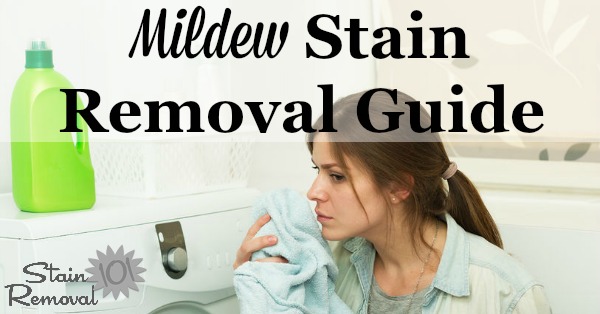
Mildew is a fungus which grows and thrives in areas which are dark, warm and damp. That means it is common in bathrooms and laundry rooms, and also in wet clothing that is not properly washed and dried, or in carpets and upholstery that gets wet and does not properly dry.
Not only is mildew not fun to look at, it also has a very unpleasant smell and can make you feel sick.
Finally, even when you get rid of the mildew itself (which is no small feat) you may find that the mildew has left behind stains on all types of surfaces, which can be quite difficult to remove.
A note of caution before I begin: Mildew and mold can be harmful to your health, and may also be difficult to remove. If the steps suggested below do not work you may need to call in a professional to both remove the mildew itself, and also for the stains.
Removing Mildew From Fabric And Mildew Stain Removal From Clothing
Step 1: Take the item outside and there shake or brush off as much of the mildew as possible.
Hint: You want to do this outside because you don't want to spread the mildew and its spores around your home further.
Step 2: Determine whether chlorine bleach is safe for the fabric, or not. If chlorine bleach is safe go to Step 3a, and if not, go instead to Step 3b.
Hint: If you can use chlorine bleach on the fabric this is your best bet, because the bleach will kill the mildew and is generally effective for removing the mildew stain.
Step 3a: If your fabric care label allows the use of chlorine bleach then launder the fabric with laundry detergent and bleach in the hottest water allowed for the fabric.
Hint: You may want to allow the fabric to soak in the laundry detergent/bleach water inside the washing machine for thirty minutes during the cycle for really tough mildew stains.
Step 3b: If your fabric care label states only color safe bleach is allowed then you should soak the fabric in a solution of oxygen bleach and hot water for at least half an hour, and then launder as usual.
Hint: Make sure the spot is gone after washing, but before you place in the dryer or you may set it.
The following tips are for really stubborn mildew stains on fabric:
Step 4: Blot hydrogen peroxide onto the fabric, then rinse and relaunder.
Step 5: Take the stained fabric out to dry in the sunlight.
Hint: Sunlight is a natural bleaching agent and can both stop the growth of mildew and also, sometimes, bleach away the spots.
You can also try adding lemon juice and salt to the stained area before sitting the cloth out in the sun, as explained more in this article about cleaning and stain removal uses of lemons.
Removing Mildew Stains From Upholstery
Step 1: Vacuum up as much of the mildew as possible.
Hint: After vacuuming up anything with mildew or mold on it you should replace the vacuum bag or empty the canister immediately, preferably outside.
Further, if it is a washable canister you should wash it out immediately with hot water and bleach to kill any mildew remaining.
Step 2: Mix a solution of one cup cool water and one cup ammonia.
Step 3: Using this solution, sponge the mildew stain with a clean white cloth.
Hint: Ammonia, especially in such a high concentration as suggested here for upholstery mildew stain removal, can be harmful to some upholstery fabrics. Therefore, before using this solution on your mildew stained upholstery you should test it in an inconspicuous area to make sure it will not harm the fabric or fibers.
Step 4: Next, blot at the stain until the liquid is absorbed.
Step 5: Repeat steps 3-4 until the stain caused by the mildew is removed from the upholstery.
Step 6: Now that the stain is removed you should get plain cold water and a new white cloth and sponge the area to remove the cleaning solution, and then blot dry.
Hint: Be sure to get the upholstery only as wet as necessary for mildew stain removal.
Step 7: Aid the drying of the upholstery by using a hair dryer on a cool setting or setting up fans around the upholstery to make sure both the fabric, and the interior of the upholstestered furniture completely dry.
This last step is crucial because mildew can quickly regrow and come back if an area remains damp, so the upholstery must be thoroughly dried to help prevent mildew re-growth.
You can get more information on how to clean upholstery here.
Hint: If the mildew is not just on the surface, but has gotten deep into the upholstery you will most likely not be able to remove it yourself, and will need to call in a professional.
How To Clean And Remove Mildew In Carpet
Step 1: Vacuum up as much of the mildew as possible.
Hint: After vacuuming up anything with mildew or mold on it you should replace the vacuum bag or empty the canister immediately, preferably outside.
Further, if it is a washable canister you should wash it out immediately with hot water and bleach to kill any mildew remaining.
Step 2: Mix a solution of two cups cool water and one tablespoon of dishwashing liquid (or liquid laundry detergent).
Step 3: Place this solution in a mixing bowl and use an electric mixer set at medium speed to mix the solution to create a foam.
Step 4: Blot this foamy cleaner onto the mildewed carpet, repeating as needed until the spot is removed.
Step 5: Now that the spot is removed you should get plain cold water and a new white cloth and sponge the area to remove the cleaning solution, and then blot dry.
Hint: Be sure to get the carpet only as wet as necessary for mildew stain removal.
Step 7: Aid the drying of the carpet by using a hair dryer on a cool setting or setting up fans around the carpet to make sure both the surface, but also the carpet backing and pad get completely dry.
Just as with cleaning upholstery mildew stains above, step 7 of this process is crucial to make sure the mildew does not return.
Hint: If the mildew is not just on the surface of the carpet, but has gotten deep into the carpet backing or pad you will most likely not be able to remove it yourself, and will need to call in a professional.
Bathroom Mildew Removal And Removing Mildew From Hard Surfaces
Bathrooms and anywhere else damp are excellent locations in your home for mildew growth.
Check out these tips for removing bathroom mildew for cleaning mildew in your bathroom.
You can also try these homemade mildew cleaner recipes for use on hard surfaces such as plastic and tile.
Finally, mold and mildew can build up in your washing machine which can contribute to it having that funny "washing machine smell." In addition, here's my article on how to clean your washing machine to get this smell out!
In addition, if you need them, here's more tips for cleaning and removing these stains from hard surfaces.
Do You Have A Mildew Stain Removal Or Mildew Cleaning Tip To Share?
Do you have your own tip for cleaning or removing mildew stains? If so, submit your stain removal tip here, or read other tips and ideas already submitted for fabrics and fibers.
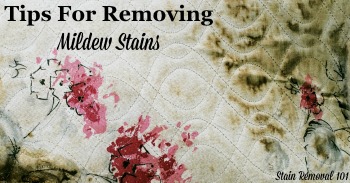
Get Even More Stain And Spot Removal Help Here
Are you a stain magnet like me? If so, check out the A to Z Stain Removal Guide which gives directions for how to remove over 100 types of stains from all kinds of surfaces.
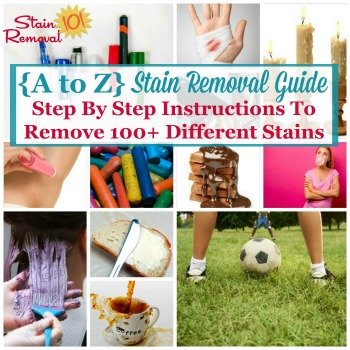
Thanks For Visiting My Website: Grab Your Free Gift!

Hi, I'm Taylor, a busy mom with 3 kids, so I have lots of hands on experience with house cleaning, laundry and my fair share of spots, spills and other messy catastrophes. Thanks for visiting my site.
I update the website all the time with tips, tutorials, cleaning recipes, reviews of products from readers like you, and tests I've done on various cleaners, removers and laundry supplies.
I'd love to give you a gift! When you subscribe to my free weekly newsletter you will receive a free printable laundry stain removal chart that you can reference as needed.
I hope you enjoy this gift, and stop by again soon!
Related Pages You May Enjoy
A-Z Guide: Instructions For Removing Over 100 Types Of Stains
Tips For Washing Swimsuits & Other Swimwear
Go From Mildew Stain Removal Guide To Home Page
CAUTION: This website is provided for informational purposes only. It is provided as is, without warranties or guarantees. Some stains and messes just won't come out, and are permanent. Further, some cleaning methods can harm your item, so if what you want to clean or launder is sentimental or expensive call a professional. See disclaimer of liability for more information.
Popular Guide Pages
Let's Stay Connected!
Get Free Email Updates
(and get a FREE printable)
Related Pages
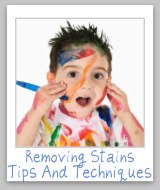 Top 10 Tips For Removing Stains
Top 10 Tips For Removing Stains
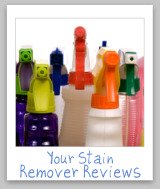 Tell Me About Your Favorite Products
Tell Me About Your Favorite Products
 Visit Household Management 101
Visit Household Management 101
 Visit Home Storage Solutions 101
Visit Home Storage Solutions 101
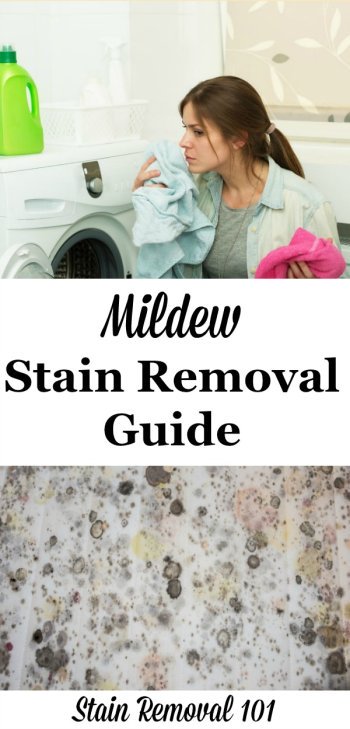

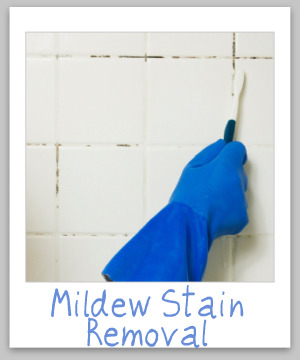
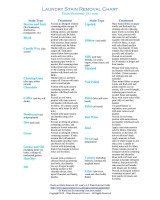
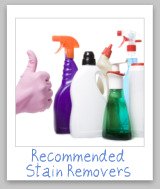
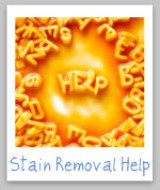
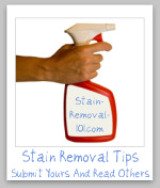
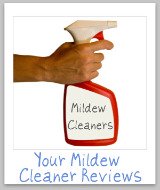
Share Your Comments, Tips & Ideas